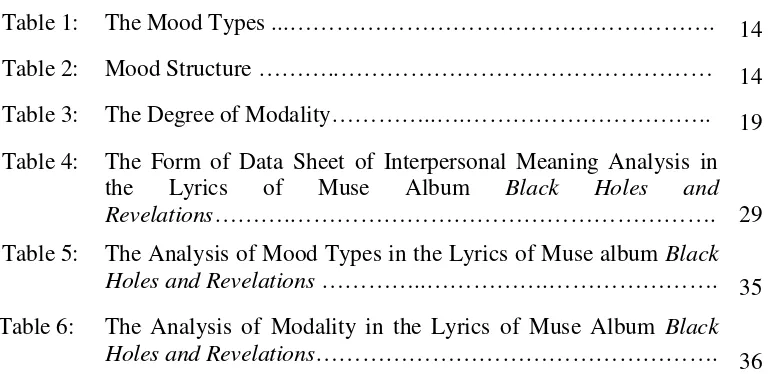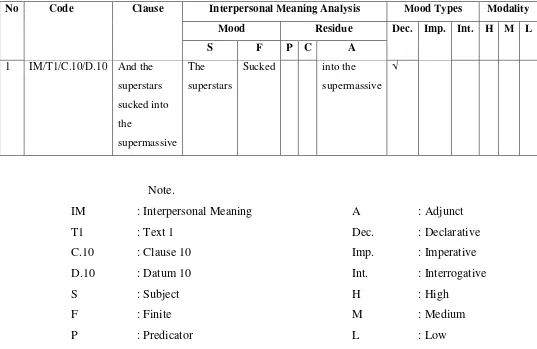Informasi Dokumen
- Penulis:
- Rowiatun Amri Marhamah
- Pengajar:
- Drs. Suhaini Muhammad Saleh, M.A.
- Paulus Kurnianta, M.Hum
- Sekolah: Yogyakarta State University
- Mata Pelajaran: English Language and Literature
- Topik: INTERPERSONAL MEANING ANALYSIS OF MUSE SONG LYRICS IN BLACK HOLES AND REVELATIONS’ ALBUM (A Study Based on Systemic Functional Linguistics)
- Tipe: Thesis
- Tahun: 2014
- Kota: Yogyakarta
Ringkasan Dokumen
I. Introduction
This study employs Systemic Functional Linguistics (SFL) to analyze interpersonal meaning in the lyrics of Muse's album, Black Holes and Revelations. The introduction establishes the context by highlighting the communicative power of music and song lyrics, emphasizing their everyday relevance and potential for academic study. It positions the research within the broader field of linguistic analysis, specifically focusing on interpersonal meaning as a means of understanding the interaction between artist and audience. The research questions are clearly defined, aiming to describe the types of interpersonal meaning, dominant mood types, and the modality employed within the selected lyrics.
1.1 Background of the Research
This section lays the groundwork by discussing the role of language in communication, differentiating between spoken and written forms. It establishes the significance of music as a powerful medium for emotional expression, arguing that song lyrics, due to their familiarity and widespread consumption, offer a rich dataset for linguistic analysis. The choice of Muse's Black Holes and Revelations album is justified, highlighting the band's stylistic diversity and the album's critical acclaim. The introduction of SFL as the theoretical framework emphasizes its focus on the functional aspects of language and its suitability for examining interpersonal meaning in textual data.
1.2 Research Focus
This section clarifies the specific aspects of interpersonal meaning that will be investigated, namely the analysis of Mood and Modality within the chosen lyrics. The three chosen songs from the album are identified, setting the boundaries of the analysis. The focus on Mood (including declarative, interrogative, and imperative) and Modality (exploring probability, obligation, and the writer's attitudes) provides a detailed framework for examining how the lyrics create interpersonal meaning and engage the listener.
1.3 Research Questions and Objectives
The research questions are explicitly stated, guiding the subsequent analysis. They directly address the types of interpersonal meaning, prevalent Mood Types, and the Modality present in the lyrics. These questions are directly linked to the stated objectives, which aim to systematically describe the identified linguistic features. This clear articulation ensures the research remains focused and directly addresses the central inquiry.
1.4 Significance of the Research
This section emphasizes the practical and pedagogical benefits of the research, addressing its relevance to musicians (understanding the communicative power of their work), students (introducing SFL and enhancing analytical skills), and lecturers (providing valuable material for teaching SFL). The potential for further research in similar areas is also hinted at, establishing the broader contribution of the study.
II. Literature Review
This chapter provides a comprehensive overview of the theoretical underpinnings of the study, reviewing relevant literature on Systemic Functional Linguistics, interpersonal meaning, music analysis, and the band Muse. It also examines prior research that has employed similar methodologies and explores relevant analytical constructs. This section is crucial for establishing the context and justification of the chosen approach.
2.1 Theoretical Description
This subsection presents a detailed explanation of Systemic Functional Linguistics (SFL), focusing on its key tenets and its relevance to the study of interpersonal meaning. Halliday's three metafunctions (ideational, interpersonal, textual) are discussed. Specific attention is given to interpersonal meaning, including Mood and Residue analysis, the identification of Mood Types (declarative, interrogative, imperative), and Modality (exploring concepts like probability and obligation). The section also includes a discussion on the role of modality in expressing the speaker's attitude and creating specific interpersonal effects.
2.2 Previous Research Findings
This section provides a review of existing research related to interpersonal meaning analysis, focusing on studies that have used SFL as a framework. The studies reviewed provide a context for the current study, highlighting the methodologies and findings of past research and demonstrating the ongoing interest in using SFL for analyzing different types of text. It establishes the study's place within the existing body of knowledge.
2.3 Conceptual Framework
This section illustrates the theoretical model guiding the analysis. It maps out the relationship between the chosen theoretical framework (SFL), the research questions, and the method of analysis. By clearly articulating the connection between theory and methodology, this section enhances the transparency and rigor of the research process.
2.4 Analytical Construct
This part outlines the practical steps involved in the analysis. It details the approach used to analyze interpersonal meaning in the lyrics, illustrating the relationship between the linguistic features (Mood, Modality) and the overall interpretation of the song's interpersonal function. This provides a roadmap for the following chapters, making the analytical process clear and replicable.
III. Research Method
This chapter describes the research methodology employed in the study. It details the research design, data collection techniques, and data analysis procedures. The focus is on ensuring the transparency and reliability of the research process.
3.1 Type of Research
This section justifies the use of a descriptive qualitative approach. The rationale for choosing this approach is clearly articulated, outlining its suitability for analyzing textual data and interpreting interpersonal meaning in a nuanced way. It differentiates the chosen method from other research approaches, emphasizing its strengths in providing rich qualitative insights.
3.2 Data Preparation
This subsection explains the identification of the data source (the lyrics from Black Holes and Revelations), data collection methods (indirect observation utilizing available recordings and online resources), and the instruments used (data sheets for recording observations). This section is essential for outlining the methods used to gather and prepare the data for analysis.
3.3 Technique of Data Analysis
This section details the step-by-step process employed to analyze the data. It outlines the procedures used to identify and categorize Mood types and Modality, ensuring the analysis is systematic and replicable. The systematic approach enhances the credibility of the findings.
3.4 Data Trustworthiness
This part describes how the validity and reliability of the findings were ensured. It highlights the measures taken to enhance the credibility of the research, such as rigorous data examination and the use of triangulation techniques to confirm the interpretations. This enhances the overall quality and trustworthiness of the research.
IV. Findings and Discussion
This section presents the results of the analysis and interprets them within the framework of SFL and relevant literature. It provides a detailed account of the findings, linking them back to the research questions and objectives.
4.1 Findings
This part presents the data analysis results concerning interpersonal meaning in the lyrics, including the identified Mood Types and Modality. This is typically presented using tables and/or figures to summarize the quantitative aspects of the findings. The clarity of presentation is crucial for understanding the results.
4.2 Discussion
This subsection interprets the findings within the theoretical context. It explains the significance of the identified linguistic features, relating them to the overall communicative intent and the interpersonal relationships established between the artist and the listener. This section provides a detailed interpretation of the results, connecting them back to the research questions and objectives. The discussion should also consider potential limitations of the study and suggest avenues for future research.
V. Conclusions and Suggestions
This chapter summarizes the key findings, restates the conclusions in relation to the research questions, and offers suggestions for future research or applications of the study's findings.
5.1 Conclusions
This section summarizes the main findings of the study, clearly and concisely answering each of the research questions posed in the introduction. It reiterates the key observations about interpersonal meaning, Mood Types, and Modality in the chosen song lyrics, demonstrating a clear connection between the analysis and the overall research goals.
5.2 Suggestions
This section proposes avenues for future research based on the study's findings. It may also include recommendations for how the research could be applied in a practical context, such as informing music education or influencing future songwriting techniques. These suggestions should be grounded in the study's results and clearly outline the potential impact of the research.





